Asparagus
In terms of ease of care, the most unpretentious are ornamental species such as asparagus pinnate and sickle-shaped. This representative of the asparagus family is perfect for a novice plant grower. Due to its aesthetic appearance, it is often used in interior design.
- Asparagus can grow well in partial shade and in bright diffused light. You can use it in the country, because it is not afraid of moderate temperature fluctuations. If it is very hot, then just increase the frequency of watering.
- It is enough to water asparagus twice a week in the summer, and in winter only 1 time is enough. It is important that the top of the soil dries out a little.
- Top dressing can be applied every month during the cold season, and in the summer it is worth increasing the frequency by 2-3 times.
- As for transplanting, it is required only when the plant is already becoming cramped in the old pot. Approximately no more than once a year. The best way to transplant is transshipment, so as not to damage the roots.
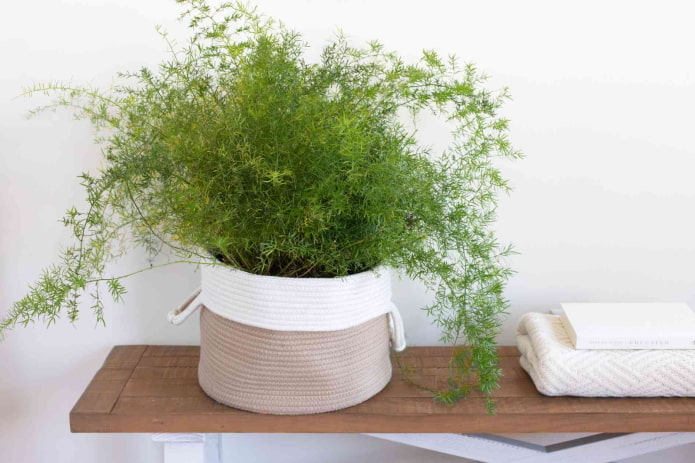
Aloe
It belongs to succulents, loved by many gardeners for the healing properties of its leaf juice. With the help of the juicy pulp of aloe leaves, you can treat a runny nose. The unpretentious plant also has wound-healing and anti-inflammatory properties. For medicinal purposes, it is necessary to use specimens that are three years old or older.
- Aloe is easy to grow, since it does not require spraying.
- Aloe needs to be watered every week in the summer and no more than twice a month in the winter months.
- This easy-to-care-for indoor plant grows well on a windowsill, however, it must be protected from direct sunlight.
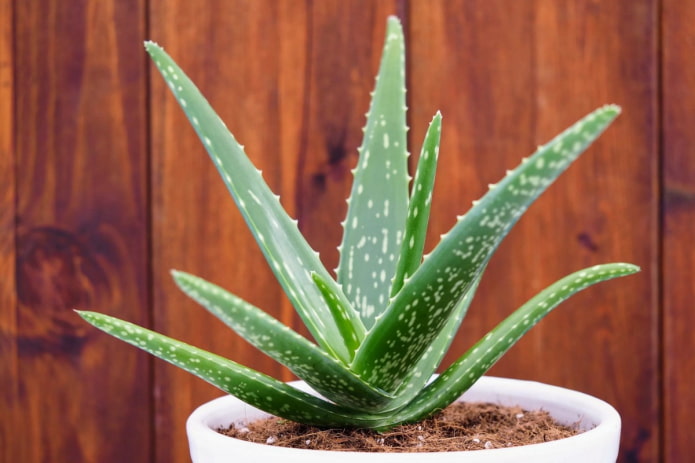
Aspidistra
One of the most shade-loving plants in our selection, which will decorate your apartment with its juicy green leaves. Aspidistra alta, commonly known as Asian lily of the valley, is usually used for growing. If you have little time for care, this plant will suit you best.
- Aspidistra is not demanding in terms of lighting, so this plant is often used in the bathroom or hallway.
- As for the temperature, 15-20 degrees will be optimal. If the temperature is higher, then simply increase watering.
- The main thing is not to overwater, and it is better to get rid of excess. Aspidistra will tolerate well even if you forget to water it a couple of times. Water it twice a week in the summer, but once a week is enough in the winter.
- I recommend being very careful when replanting, since the roots of the aspidistra are very fragile. It needs to be replanted approximately once every 3 years.

Chlorophytum
Due to its fast growth, attractive appearance and ability to purify the air from various impurities, chlorophytum is often used for landscaping an apartment. Due to the ability of this unpretentious flower to filter the air, it is most often placed in the kitchen.
- This plant is very easy to care for. It is enough to water moderately after the soil surface dries out and to fertilize every month from spring to autumn.
- For the chlorophytum to grow lush, it is necessary to provide it with good lighting.
- When the air becomes dry during the heating season, it is necessary to increase the humidity by spraying.
- It is necessary to replant when the root system has grown strongly.
- With proper care, the unpretentious chlorophytum will definitely show itself in all its glory and hang rosettes on the ends of the peduncles, so it can be grown in hanging pots.
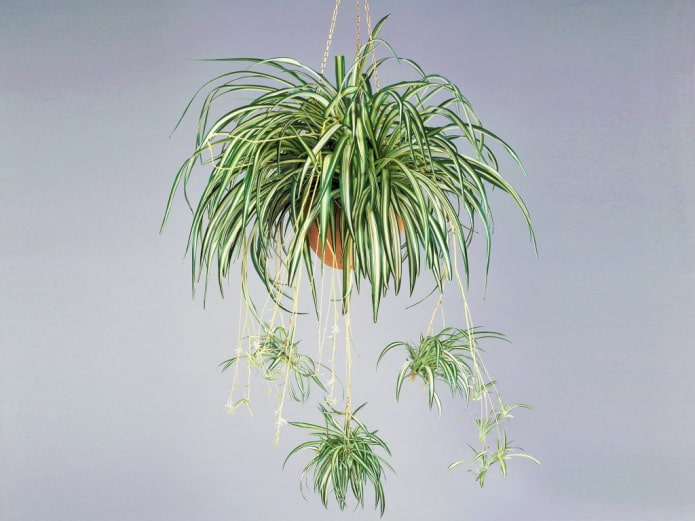
Aglaonema
This plant with beautiful large leaves and unusual coloring will decorate any apartment. It comes from the tropical forests of Asia, and accordingly, care recommendations directly depend on this. It is easy to care for and absolutely unpretentious to the conditions of maintenance. The main thing is that there are no drafts.
- Absolutely undemanding to light and feels great in the shade and in diffused light.
- The air should be warm within 16-25 degrees. Loves sufficient humidity, especially at upper temperature limits.
- Periodically moisten the leaves and spray Aglaonema. Once every 7 days is enough. The soil should be slightly moist, but without excess moisture.
- I recommend replanting every 2 years.
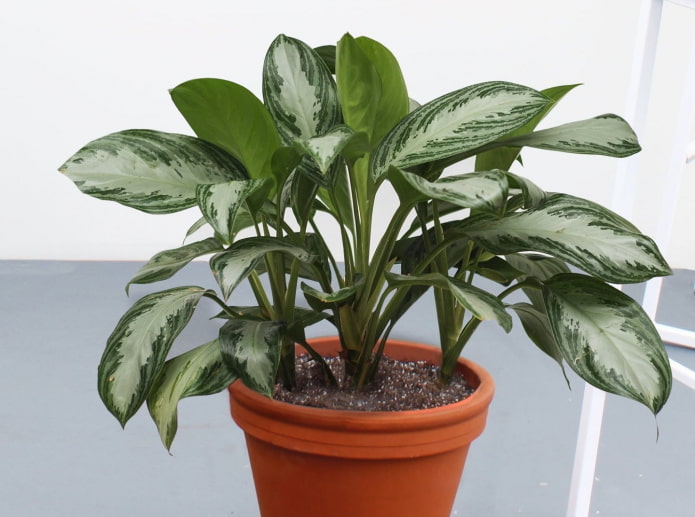
Pelargonium
Pelargonium or geranium combines a lot of advantages. The flower helps purify the air. Velvety pubescent foliage and flower caps of pastel, rich or combined shades make this unpretentious plant a real decoration for windowsills.
- In the summer months, pelargonium feels great outdoors, so it can be used to decorate a balcony or terrace.
- The rich aroma of the leaves can repel insects, including moths, so the flower is not susceptible to pests.
- By following simple care rules, you can achieve abundant flowering.
- The plant requires good lighting.
- Pelargonium tolerates a lack of moisture better than an excess.
- In summer, it is necessary to water it only after the soil surface dries out, in winter watering is reduced to a minimum.
- After flowering and in early spring, it is necessary to prune overgrown shoots to form the shape of the bush and promote lush flowering.
- Feeding has a beneficial effect on pelargonium, so you can add it in the warm season.
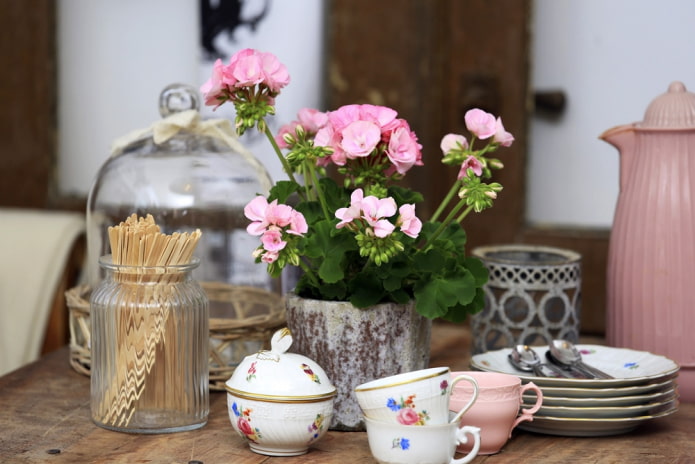
Dracaena
A fairly popular plant that is also easy to care for. Dracaena with dark leaves is less demanding of lighting, but with bright ones, more effort will be required.
- In hot weather, water the dracaena once every 7 days, and in winter you can less often – once every 10-12 days. Focus on the soil condition.
- For the plant to actively grow and develop, maintain the correct temperature in the range of 18-25 degrees. Although lower temperatures will not kill it, you should not abuse it.
- It is better to place the pots in moderate lighting. Western and eastern windows are best. On a bright sunny day, it is better to protect Dracaena from direct rays.
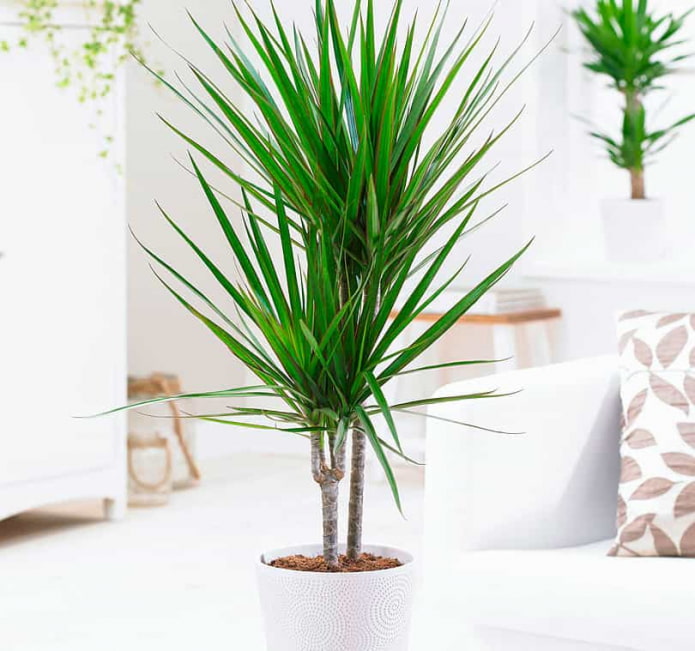
Spathiphyllum
It is believed that this flowering houseplant helps to find happiness and love. The unpretentious “women’s happiness” is also valued for its beauty. Delicate green leaves in combination with white bedspreads of graceful flowers look very impressive and noble.
- This unpretentious indoor flower prefers diffused light and regular watering.
- Dropped foliage indicates a lack of moisture and rises immediately after watering.
- To prevent the tips of the leaves from drying out, spraying is required.
- In the warm season, spathiphyllum needs to be fed once every 30 days.
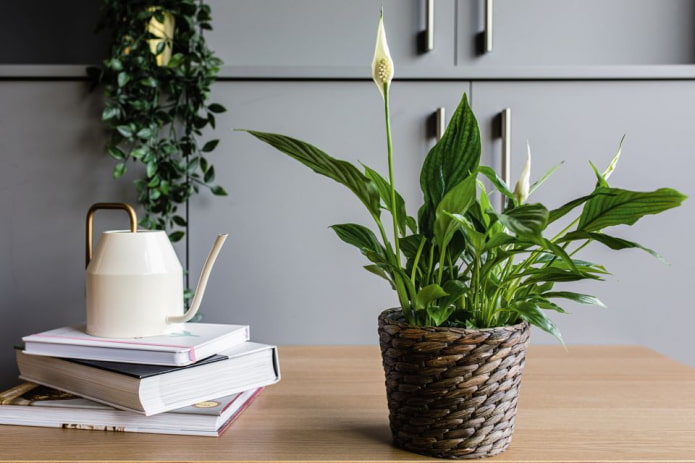
Decembrist
Schlumbergera (Decembrist) is a representative of the cactus family, whose peculiarity is flowering in the winter period, when many indoor flowers are dormant. A multitude of pink, white, red or purple flowers decorate the house for several weeks.
- For abundant flowering, the Decembrist must be kept at low room temperatures.
- In summer, the plant requires abundant watering after the soil dries out, however, nothing will happen to it if you forget to water the Decembrist on time.
- The unpretentious plant tolerates direct sunlight if you gradually accustom it to it.
- Replanting adult specimens is carried out every 5 years.

Sansevieria
Popularly known as Our grandmothers also grew “mother-in-law’s tongue” or “pike tail” sansevieria. This unpretentious plant is popular with several generations at once.
There are both compact varieties and specimens reaching a meter in height. Dense, elongated leaves have a variegated color and a light border along the outer edge. Sansevieria blooms with small inflorescences with a pronounced sweet aroma.
- This plant is suitable even for novice gardeners. It feels comfortable both in partial shade and in bright sun, however, specimens growing in the back of the room lose their expressive color.
- It is necessary to water every 7 days, in winter – every 2-3 weeks.
- Replant when the flower becomes too cramped in the pot.
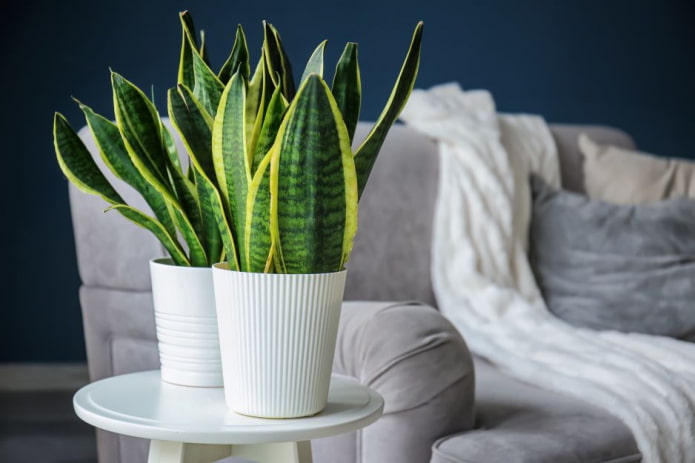
Cactus
Cactus is rightfully considered an unpretentious plant, since it, like all succulents, stores moisture and is able to do without watering for a long time. Some cacti can thank the grower with the appearance of beautiful flowers. Not every cactus blooms at home, and the flowering period sometimes lasts only one day, however, this does not detract from its decorative qualities.
- Does not require special care.
- The unpretentious cactus is not afraid of direct sunlight, so it can grow on a windowsill.
- It stretches out in the shade, so it is not recommended to place it in the back of the room.
- The flower is resistant to dry air and heat.
- Excessive watering can be a mistake in care.
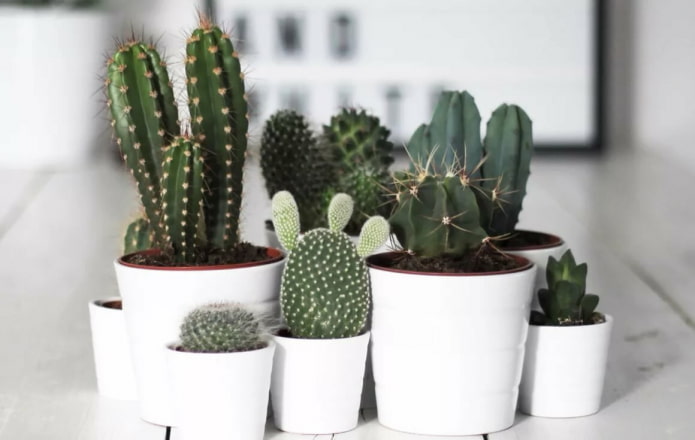
Violets
Uzambara violet or Saintpaulia is found among many flower growers. A rich palette of shades and shapes, regular flowering, fleshy foliage and compactness of these plants ensure their popularity.
- Flower care is minimal.
- Fluffy leaves of violets must be protected from moisture and bright sunlight.
- Since flowers cannot be sprayed, in hot weather and the heating season it will not be superfluous to provide comfortable humidity in the room.
- In summer, the flower needs to be watered 2 times a week, in winter – much less often.
- Violets need to be fed every two weeks.
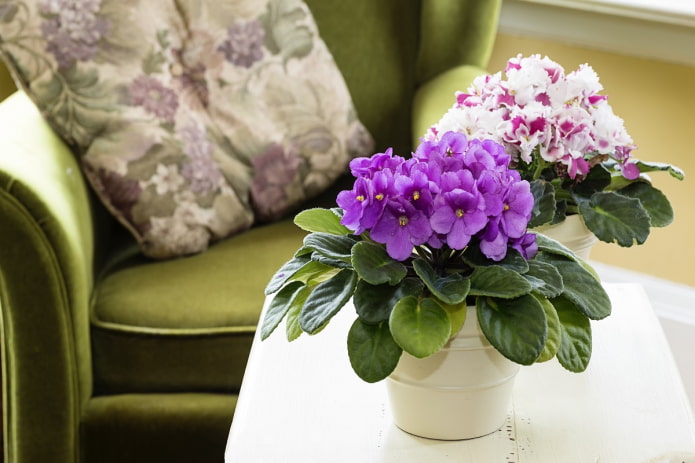
Tradescantia
This climbing plant will perfectly decorate the kitchen and any living room. Tradescantia comes from the tropics and has juicy and colorful leaves. It grows quite quickly and at the same time perfectly purifies the air. Most often it is placed in hanging pots, and the shoots are carefully placed along the walls.
- It loves bright diffused light, so it is better not to place it in the shade.
- The temperature of the content ranges from 18 to 26 degrees.
- On hot days, it should be watered abundantly – approximately every 3 days, and in winter, focus on the dryness of the soil.
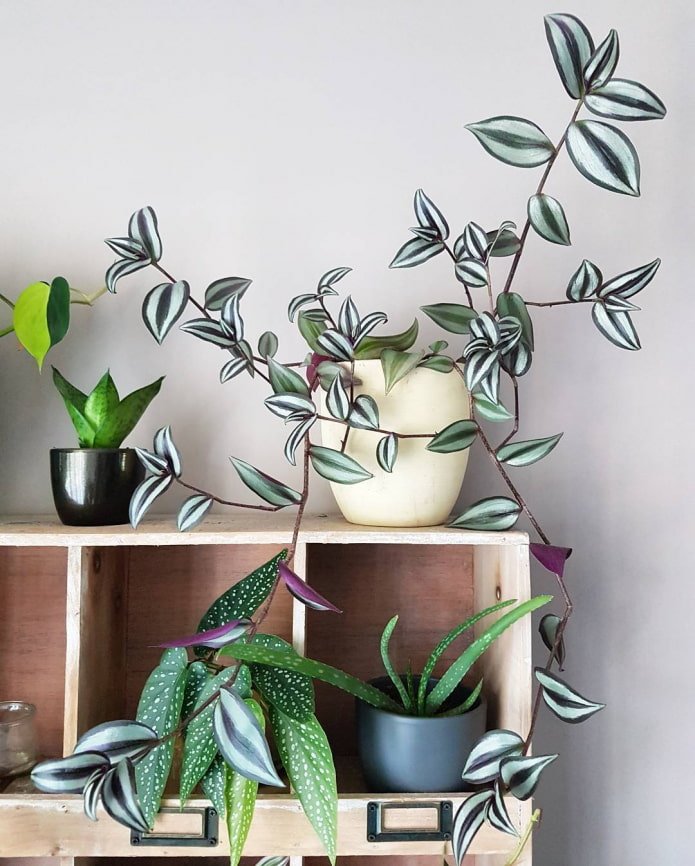

Monstera
A large decorative foliage plant looks impressive in spacious rooms. There are varieties with a single-color and variegated color. The leaves can reach a meter in length, and the slits on them give the plant an attractive appearance.
- The unpretentious monstera is sensitive to watering and temperature. The plant stops growing if the thermometer drops to 12 degrees. The optimal temperature is about 20-23 degrees.
- You do not need to water the plant often, waiting until the top layer of soil dries. In winter, watering is reduced to once a week or even twice a month.
- With insufficient light, new leaves become smaller, and the slits on them may stop appearing altogether, so it is better to provide bright diffused lighting.
Monstera is a climbing plant, so its stem may require additional support.

Hoya
Wax ivy is an unpretentious creeping plant with small inflorescences that exude a sweet aroma. Nectar is formed on the flowers, which is why hoya is also called a “weeping vine”. Dense glossy leaves, a variety of colors, regular flowering and ease of care are the main advantages of hoya.
- It feels comfortable on a sunny windowsill and is not afraid of temperature changes.
- In summer, the unpretentious flower needs increased watering, however, a short-term lack of moisture does not harm it.
- Hoya planted in a tight pot blooms more abundantly.
- During flowering, do not unfold the flower and move it, otherwise the flower may shed buds.
- Faded shoots do not need to be cut off – it is on them that new inflorescences will appear in the future.

Ficus
All ficuses are decorative in their own way. There are monochromatic and variegated species, compact specimens resembling a bush, and tall trees with elastic leaves.
- To place an unpretentious ficus, it is better to choose a place with diffused light.
- It is not recommended to move the ficus from one place to another often.
- The ficus loves high humidity, so it must be sprayed at least during the heating season.
- Due to too much or insufficient watering, the ficus can shed its leaves, so it is necessary to monitor the condition of the upper layer of the earthen lump and water it after it dries out.
- To form a crown in the spring, the flower requires pruning.
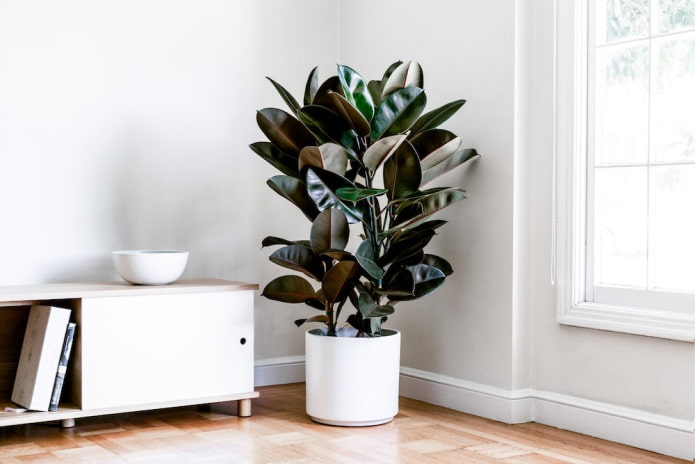
Hibiscus
The woody stem and branches of the Chinese rose turn this indoor flower into a spectacular bush that amazes the imagination with large flowers of red, peach, pink or white shades. Single flowers bloom for only one day, but in the warm season flowering is continuous, so the owner of the flower has time to enjoy its beauty.
- Unpretentious hibiscus is not demanding to the location, but abundant flowering can only be achieved in the light.
- Flowering is favorably affected by the temperature regime – in the cold season it should be about 18 degrees.
- Formative pruning is performed in early spring.
- Fertilizers must be applied monthly in the spring-autumn period.
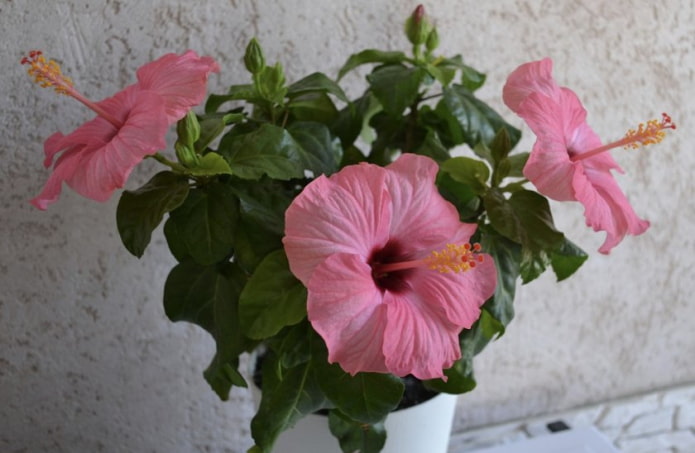
Zamioculcas
Branches with glossy leaves form from tubers located in the ground. The waxy coating protects the plant from drying out, so the zamioculcas accumulates moisture.
- This easy-to-care-for flower can be grown in the shade, but with sufficient lighting it develops faster and does not stretch out.
- To prevent the roots from rotting, watering should be moderate.
- Zamioculcas does not respond to changes in air humidity, so it does not need spraying.
- This indoor flower is characterized by slow growth, which can be accelerated by adding cactus fertilizer twice a month.
- Since the plant’s juice is poisonous, zamioculcas should be placed out of the reach of children, and transplantation work should be carried out with gloves.
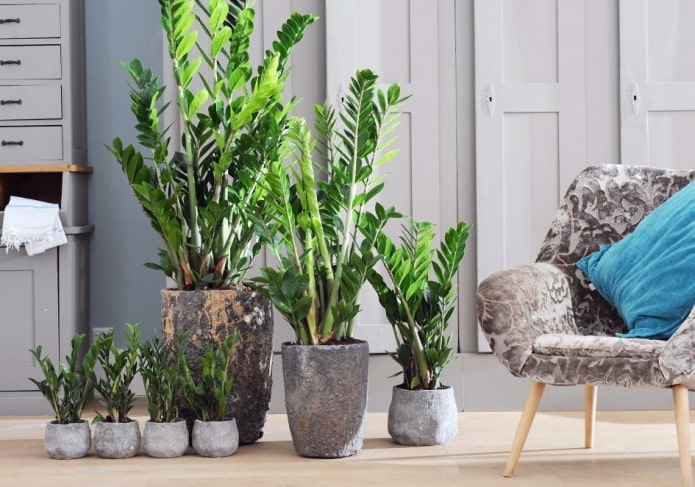
Phalaenopsis
The beauty of orchids is admirable. Large plants with large flowers and compact mini-orchids will perfectly complement any interior or will be a wonderful gift. The unpretentious flowering houseplant has long ceased to be exotic, since it pleases with repeated flowering, without requiring complex care.
- The orchid comes from the tropics, so ordinary flower soil is not suitable for growing it. Phalaenopsis should be planted in a pot filled with bark, moss and coconut fiber.
- For the plant to grow healthy, its roots should be in the light.
- Transparent pots with side holes or slits that provide access to sunlight and air flow are great for orchids.
- The color of the roots can determine the need for watering: if the roots are silvery, the plant needs moisture.
- If you dry out the houseplant too much, it will shed its buds.
- Spraying and a warm shower have a beneficial effect on the health of the tropical beauty.
- Feeding is essential for this plant, since it does not receive the necessary nutrients from the substrate and water.
- A wide range of fertilizers for orchids makes it easy to find the right fertilizer.
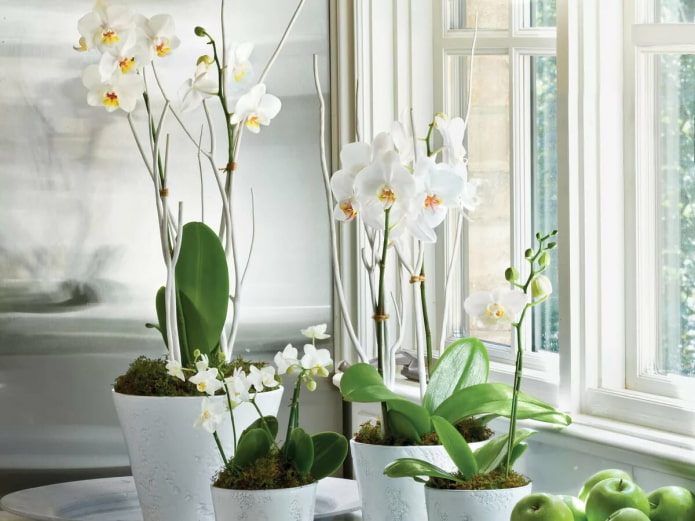
Crassula
Some gardeners still believe in the signs of prosperity associated with the money tree. This unpretentious flower is attractive for its beauty. Tight fleshy leaves and a spreading crown shape of an adult plant make it an excellent choice for arranging a home flower garden.
- Crassula, also known as “fat woman”, can go a long time without watering, since the juicy leaves contain enough moisture.
- It is not demanding in terms of air humidity and fertilizing. These procedures will not be superfluous, but without them the plant will not die.
- The money tree is not afraid of sunlight and grows well on a windowsill.
- The soil must be well permeable to moisture and provide air permeability.
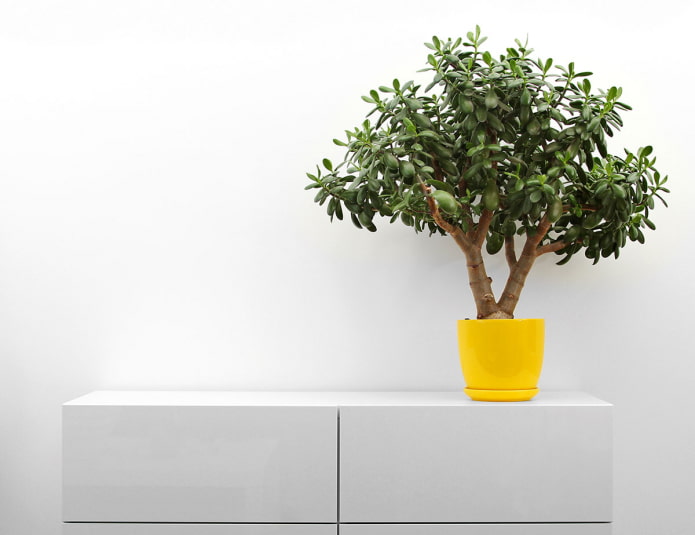
The indoor plants offered in the article can transform the environment. Undemanding in care, they are perfect for both beginners in floriculture and experienced gardeners who want to save their time.
Now reading:
- Ideal flowers for the balcony: 41 options for different types of balconies.
- What to do if the bed creaks? We will find the reasons and the source of the sound.
- Fiat 500 Lineup: 500, 500L, and 500X Models Explained
- Euro-style renovation: key features, differences and examples in interior design.
- 12 compact plants that will become a real decoration of your garden.